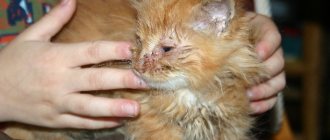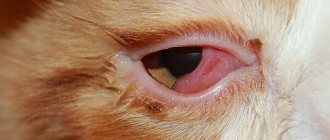Ear mites in cats can cause a disease such as otodectosis . Both street and domestic animals can get it. This disease is quite easy to diagnose, but still, the signs of ear mites in cats can only be determined with the help of a specialist.
You can cure ear mites quickly if you identify the onset of the disease and seek help from professionals and do not delay treatment. To prevent this from happening, it is necessary to examine the condition of your pet’s hearing aid. You should monitor him especially carefully if he has contact with street animals.
Ear mites are quite common. Affects the skin of the animal. When examining a cat's ear, you may notice a small round formation about 0.5 millimeters in size.
These are ticks.
Ticks attach .
They usually affect the external auditory canal and eardrum. In kittens, the inner surface of the ear also suffers. They are more susceptible to this disease. Ear mites in cats and adult cats are much less common.
People do not get sick from cat diseases and the fear of getting infected from a pet is unfounded. But, if the parasite gets on the owner’s things, it can become an intermediate link
in the spread of the disease.
What are ear mites?
The ear mite (Otodectes cynotus) is a fairly close relative of the spider, a small arthropod belonging to the class of parasites. It usually chooses dogs and cats as “hosts,” causing them to develop a dangerous disease called otodectosis (popularly known as ear scabies). Ticks like the warm and moist environment inside the animal's ear - they settle there, becoming a source of mechanical irritation and provoking inflammatory processes. Ear mites in cats are not a death sentence, but if you are faced with a cat ear mite problem, treatment is necessary, otherwise you may lose your pet.
What does an ear mite look like in cats?
This insect is pale yellow in color with an oval body of uneven contour up to 0.6 mm long. If you suspect a disease, you can carefully insert a cotton swab into the securely fixed animal's ear and remove several parasites along with their waste products. By placing the stick on a dark surface, you can see and find out with your own eyes what ear mites are in cats; Photos of this harmful insect are presented in abundance on the Internet, and comparing these pictures and what you get from a cat’s ear is a matter of just a few seconds. If your vision leaves much to be desired, it is recommended to use a magnifying glass.
Folk remedies
At an early stage of invasion, a course of treatment based on the use of folk remedies will be sufficient. After cleaning the animal’s ears, instill daily:
- Green tea infusion. 2 tsp leaves are brewed 1 tbsp. boiling water, leave, wrapped in a towel, and cool. The product is administered 2-3 drops throughout the month.
- Almond (lavender, mint) oil. 2 tbsp. l. any of the oils or a mixture of them is mixed with a crushed clove of garlic. Leave the mixture for 24 hours, then strain. Apply 1 time per day.
- Celandine juice. Fresh herbs can be ground using a meat grinder and the juice can be squeezed out. Apply 2 times a day, 2 drops in each ear.
How cats become infected with ear mites
The main source of ear mite infection for domestic animals is their stray brothers. To get sick, you don’t even have to have direct contact with a stray cat or dog—interacting with an object they recently scratched themselves on is enough.
The following route of spread of parasites is also likely: a sick animal walked along the ground, shaking off a tick, and a person brought it into the house on the soles of shoes, or the cat itself, if free-range is practiced, picked up the infection on its paws or fur.
In addition, fleas and flies are carriers of otodectosis.
Prevention
Otodectosis is considered the most common disease, because... It is easily transmitted from one animal to another, but preventing its occurrence is easier than treating it. Prevention of otodectosis in cats is to avoid contact with sick animals. Caution must also be observed when visiting exhibitions and clinics. You should use flea collars while walking.
Once a month, you can treat the ear canals with lotions. Veterinary pharmacies have special formulations designed for preventive procedures that can even be used for kittens.
A properly balanced diet and additional vitamins and minerals will help strengthen your cat’s immunity.
In addition to regular examinations of the animal, weekly wet cleaning of the premises using antiseptics should become a useful habit. It is necessary to clean not only the animal's beds, but also door mats, shoes, and people's outer clothing.
Ear mites: course of the disease
Like most diseases, otodectosis develops gradually, and in the first stages of the disease, signs of ear mites in cats can be almost invisible to the owner. Further, when ear mites in cats progress, the symptoms are very characteristic:
- the pet’s behavior becomes restless - the cat can run, meow, rub its ears on objects, scratch them persistently, sometimes even tearing blood with its claws;
- the appearance of an unpleasant odor from the cat's ears;
- discharge from the auditory openings of a dark brown liquid or a substance resembling an ointment in structure, or the appearance of scabs in the auricle;
- hearing loss in cats or the onset of complete deafness;
- increase in body temperature.
If the disease is neglected, it will spread deeper into the ear canal - into the middle and inner ear. This is followed by the final stage of the disease - inflammation affects the meninges, as a result of which the cat dies.
Why is the disease dangerous?
Ear mites consume particles of the epidermis, which severely damages the skin. If treatment is not started on time, the disease will lead to dangerous consequences for health:
- suffering from unbearable itching, the animal sometimes scratches its ears until they bleed, damaging the capillaries - large hematomas appear;
- microtraumas on the skin open the way for infections, inflammation begins, the ear swells, redness and suppuration appear;
- the eardrum and inner ear become inflamed, and otitis media develops.
Delayed initiation of treatment leads to hearing loss and then to hearing loss. The cat is restless and irritated, cannot fully rest due to constant discomfort, and becomes aggressive. When the disease penetrates the lining of the brain, death will occur. Ear mites are dangerous because they are quite difficult to recognize, hence the frequency of advanced cases when it is very difficult to save the animal.
How to cure ear mites
If you suspect that your cat has ear mites, you should contact a professional who knows how to get rid of parasites as soon as possible. An experienced veterinarian will immediately recognize alarming symptoms, and the treatment that he will prescribe after identifying the disease can be carried out independently.
The main directions of therapy for otodectosis:
- manually reducing the number of mites in cat ears - regular ear cleaning and physical removal of parasites with their further destruction;
- the use of external medications for “chemical warfare” against ear mites: instilling, pouring or spraying these drugs into the cat’s ears;
- elimination of the inflammatory process by exposure to drugs from a number of antibiotics - if the disease has gone that far.
Treatment at home is not particularly difficult, but you will have to pay a lot of attention and effort to it: it is known how cats “love” to be treated, and yet the procedures must be performed regularly and for quite a long time.
To carry them out, the animal will most likely have to be swaddled - so that the “straitjacket” does not interfere with the cat’s breathing, but does not allow it to swing its paws. First of all, your pet’s ears will need to be thoroughly cleaned, removing waste products from mites and the parasites themselves. This is done with a cotton swab soaked in an antiseptic solution such as chlorhexidine or miramistin. It is acceptable, but not advisable, to use ordinary warm water instead.
Next, a remedy for ear mites in cats is injected directly into the ear. These can be ear mite drops for cats - such as Aurican or Amatrizine, or aerosols - Akrodex, Dermatosol, Tsiodrin, etc., or ointment - for example, Amidel-gel. All these medicines are affordable, and it is not difficult to purchase them in pharmacies or directly from the veterinarian to whom you came with a question on how to cure your pet.
After administering anti-tick medication for cats, you need to hold the animal on your lap, gently massaging its ears. At the end of the procedure, almond or camphor oil is instilled into the ears.
For kittens and pregnant cats, there are contraindications to the use of most common drugs for otodectosis. In these cases, you will need to specifically check with your doctor for recommendations on how to treat your pet.
Regardless of the chosen means, treatment will need to be carried out in three courses with an interval of five to six days - in accordance with the characteristics of the parasite’s life cycle. And do not forget that it is strictly forbidden to use alcohol-based products to treat ear mites in a cat.
If the cat is in serious condition and the veterinarian has determined extensive inflammation, the animal will need antibiotics - the medicine will have to be administered by subcutaneous injection. Giving cats injections is not particularly difficult, it is quite possible to do it at home yourself, just ask the doctor to show you everything and explain it clearly.
Effective treatments
You can begin therapeutic measures only after visiting a veterinary clinic. The doctor must conduct a diagnosis confirming the presence of Otodectes cynotis. For this purpose the following is carried out:
- examination with an otoscope;
- dermatological examination (skin scraping);
- laboratory procedures (blood and urine tests).
After assessing the animal's condition, the doctor will prescribe appropriate treatments for ear scabies in cats. The recommendations of professionals should not be neglected, because... Only those special preparations that will get rid of both adult parasites and their eggs can be effective in the fight against parasites.
In addition, the pet may be prescribed antifungal ointments, immunostimulants for subcutaneous administration, and antihistamines.
Even if the parasite was found in only one ear, both should be treated to prevent re-infestation. Before using medicinal drops, you must thoroughly clean the ears with antiseptics. The therapeutic course depends on the life cycle of the ticks and may take about 10 days, after which a repeat (control) diagnosis will be scheduled. Treatment can be continued if there is a suspicion of the presence of a clutch of eggs, which take 3 weeks to mature.
Are ear mites dangerous for humans?
For humans, ear mites, fortunately, do not pose a danger, so if a pet has picked it up somewhere, there is no need to worry that it will infect its owners and their children.
But other pets - cats and dogs, as well as ferrets - will be under a real threat of further spread of the parasite, therefore, so that a single case of ear mite disease does not develop into an epidemic within a separate apartment, for the entire duration of treatment you should follow the rule: isolate the sick animal from healthy, and also keep them away from his bedding and toys. In addition, it is strongly recommended that all pets be checked by a veterinarian to see if tick infestation is already an established fact. If the infection has spread, the animals should be treated at the same time. If the infected cat is a nursing mother, the kitten may also have parasites - you will need to show it to a doctor and decide whether it should be taken away from its mother and, if so, how to provide it with nutrition.
Medications
In case of severe infection, detection of blood clots, pus in the animal’s ears, it is possible to get rid of parasites only with the help of broad-spectrum drugs. Before purchasing, make sure that the list of indications for the drops or spray includes Otodectes cynotis.
In veterinary pharmacies, drugs used to treat otodectosis in cats and combat parasites are presented in an assortment. It can be:
- aerosols with insectoacaricidal action (Acrodex, Tsiodrin, Dermatosol), which should be sprayed onto the affected areas, holding the bottle a few centimeters from the ear;
- ointments, the composition of which is based on nicochloran, phenothiazine and other insectoacaricides;
- drops (Otoferonol, Amitrazine, Bars, Amitraz, etc.);
- powders (boric acid).
After applying the drugs, you need to do a light massage so that the medicinal composition is evenly distributed. Compliance with the dosage is considered a mandatory rule for the use of medications, because the compositions contain poisons that are dangerous for your four-legged friend. If other types of pets are infested, they may need other medications.











